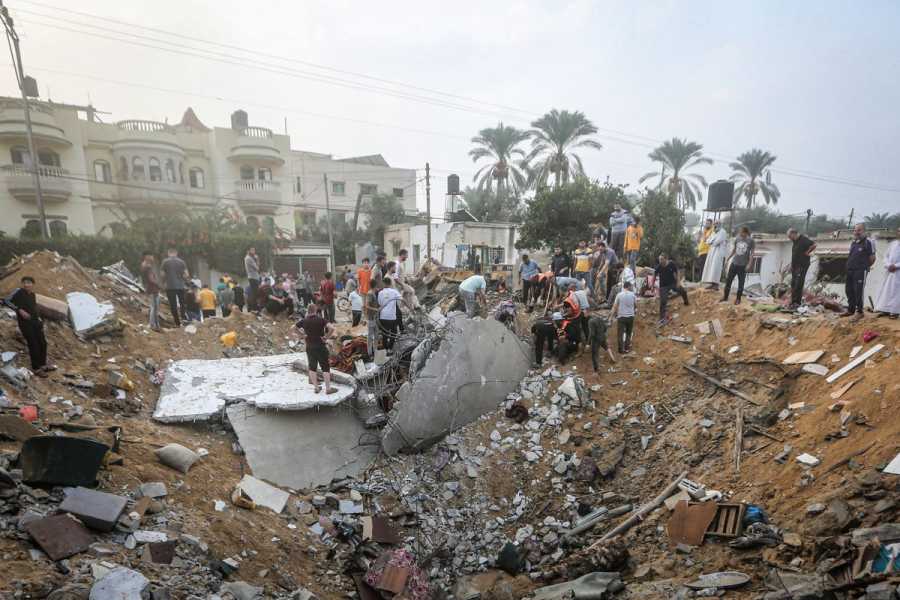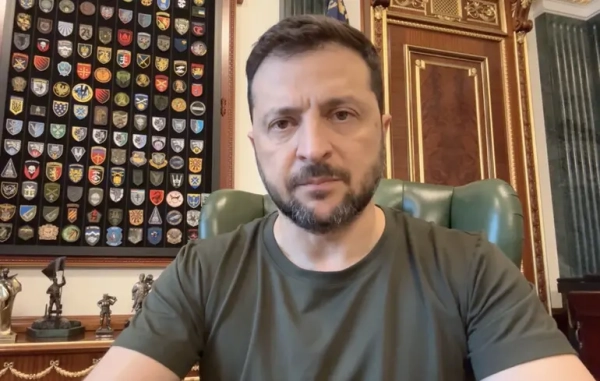Elon Musk and the other platform owners aren’t entirely to blame for misinformation around the Israel-Hamas conflict.

Palestinians stand around a crater caused by an Israeli strike in Khan Yunis in the Gaza Strip. Mohammed Talatene/Picture Alliance via Getty Images Peter Kafka covers media and technology, and their intersection, at Vox. Many of his stories can be found in his Kafka on Media newsletter, and he also hosts the Recode Media podcast.
Social media is a good place to get a lot of bad information. That’s not a new problem, but it’s particularly acute right now, during a war between Israel and Hamas.
The temptation is to put the blame for this at the feet of Elon Musk, who has seemingly tried to increase the amount of unreliable stuff on Twitter since he bought the service a year ago. You can also rail against TikTok, with its enormous influence and black-box algorithm. You can also point a finger at Telegram, a messaging service for much of the world that barely pays lip service to moderation. Then there’s Meta and YouTube and other platforms which continue to invest heavily in content moderation but are still swamped with this stuff, simply because there’s so much of this stuff.
I’m happy to cast the shame net widely. But I also think people complaining about inaccurate information on their platform of choice during a brutal conflict are also going to have to come to grips with a difficult reality: Getting the “right” info during a war — especially in real time or close to it, when that news is happening in a place where journalists may have limited access and are under dire threat themselves — is an inherently difficult exercise that may never get you the results you want.
Last week’s deadly explosion at a Gaza hospital is the newest data point in that argument: Hamas immediately blamed the strike on Israeli rockets, and initial reports from news outlets including the New York Times ran with that framing; Israel subsequently blamed an errant Palestinian missile launched from inside Gaza.
As I’m typing this, a week later, the consensus — at least in Western media — seems to have shifted toward the Israeli explanation. Meanwhile, the Times published an editor’s note on Monday that says its initial coverage “relied too heavily on claims by Hamas” and “left readers with an incorrect impression”; the paper’s most recent coverage of the blast doesn’t say the Israeli narrative is correct but does say that Hamas “has yet to produce or describe any evidence linking Israel to the strike.”
This isn’t a nihilistic, there-is-no-truth argument. Something caused that explosion and loss of life, and at some point, there will most likely be enough forensic evidence to establish what actually happened, with some degree of confidence.
But for the duration of this conflict, we’re going to have to live with the fact that a lot of what we first learn about what happens in a war is wrong, or misleading. We can’t primarily blame social platforms for that: It’s the very nature of the conflict itself.
In this case, it will be even harder to suss out the truth immediately after an incident, for a couple of reasons:
*Both Israel and Hamas have longstanding and deserved reputations for putting out misleading propaganda about their military actions.
*Journalists have very limited access to on-the-ground facts. Only a small number of them were in Gaza prior to the Oct. 7 attacks, and any reporting they undertake now is incredibly difficult and risky. Nearly two dozen of them have reportedly been killed in the first two weeks of the war. Meanwhile, the Israeli government won’t allow anyone — including journalists — to enter Gaza.
In the wake of the hospital explosion last week, we’ve seen attempts to counteract those weaknesses, with a combination of forensics and crowdsourcing: Using snippets of video and audio recorded at the time of the explosion, plus photos taken the day after the blast, researchers such as Bellingcat, a nonprofit fact-checking group, have published their own findings — which remain inconclusive.
And none of that will satisfy people who expect black-and-white answers about something that happened a week ago.
And if that’s frustrating for you, I have news you won’t like: This is likely going to get worse, for quite some time. If Israel goes forward with plans to invade Gaza, you can expect all kinds of conflicting reporting about shootings, explosions, and military and civilian casualties. And that information will be even harder to verify with tanks in the streets.
More context you won’t like: While we can blame some of this on a news environment sped up by phones and digital platforms, getting bad info about what happened in a war is a longstanding problem. And that almost always begins with the fact that most information about what happens in a war initially comes from the government fighting the wars.
That’s why, for instance, the early coverage of the death of Pat Tillman, the NFL player turned Army Ranger, at first reported he’d been killed in a 2004 ambush in Afghanistan — and not, as we eventually learned, that he’d died in a friendly fire incident. The same goes for the story of Jessica Lynch, the US soldier captured by Iraqi soldiers in 2003. Lynch later said the tale of her abduction and rescue, which received enormous attention at the time, had been distorted and exaggerated by US officials. If you want a more recent — but pre-Musk — example of how hard it is to decipher what’s happening in a war, look into the sabotage of Russia’s Nord Stream pipelines, which may or may not have been the work of Ukrainian militants.
The fog can also apply to war in places we don’t traditionally think of as war zones: While there is no shortage of reporters on the ground in Israel itself, it has still been difficult to get confirmation of exactly what happened during the October 7 attacks, leading to claims and counterclaims about specific atrocities. This week the Israeli military tried to address that by screening graphic footage of the violence for a group of reporters.
So faced with those structural obstacles that aren’t going anywhere, what can you do? One answer, counseled by Giancarlo Fiorella, Bellingcat’s director of research and training: “Slow down.”
“That’s something we’ve always been good at,” he tells me. “But in particular this past week or so, we’ve come to appreciate how that’s a skill — the ability to say, ‘Look, we’re not going to rush to publish something. Let’s take our time.’”
But I have a similarly unsatisfying suggestion: While waiting for the truth to surface in the wake of something horrible, you could spend some time … using social media.
Wait! Didn’t we just establish that the platforms are riddled with untruths?
Yes. And there’s plenty of data supporting that assertion, as well as a small group of hardworking people cataloging many of those posts that are wrong.
But it’s worth noting that not all disinformation has the same impact or ambition: Yes, Twitter and TikTok users were sharing footage of people running at Bruno Mars concert and claiming it was filmed during the Hamas attack at the Negev desert rave that killed hundreds. But that attack was real, and the mislabeled footage doesn’t change that — it was just an opportunity for people to gain social media clout.
But no matter what, you’re going to get a slew of this stuff. To help sort through it, my colleague A.W. Ohlheiser suggests using the SIFT method: “Stop, Investigate the source, Find better coverage, and Trace claims, quotes, and media to the original context.”
That may be more than what the average TikTok or Twitter user wants to do with the stuff they’re scrolling through. But since you’re deep into a story about accuracy in media, you can definitely give it a shot.
Used responsibly, and cautiously, what social media can do is open your window on the world a little bit wider. I’ve been gratified, for instance, that alongside clips from the likes of CNN and ABC News, my TikTok feed shows me excerpts from Al Jazeera and the UK’s Channel 4, which tend to be much more skeptical of Israeli claims than US news organizations. I have to caveat emptor all of that, obviously — but that has always been the responsibility of the conscientious news consumer, and I feel I’m much better off seeing how other parts of the world see the conflict. And that may be, for now, the best I can hope for. Not all of it is going to be right, but we’re not getting real-time truth right now — and in wartime, we never have.
Sourse: vox.com






